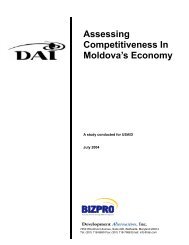Promoting Competitiveness in Practice - Economic Growth - usaid
Promoting Competitiveness in Practice - Economic Growth - usaid
Promoting Competitiveness in Practice - Economic Growth - usaid
You also want an ePaper? Increase the reach of your titles
YUMPU automatically turns print PDFs into web optimized ePapers that Google loves.
mean is that without local bus<strong>in</strong>ess leaders tak<strong>in</strong>g the lead <strong>in</strong> promot<strong>in</strong>g and driv<strong>in</strong>g the process<br />
of change, the likelihood of substantial or susta<strong>in</strong>able change is m<strong>in</strong>imal.<br />
A participatory strategic plann<strong>in</strong>g process is the start<strong>in</strong>g po<strong>in</strong>t. The participatory strategic<br />
plann<strong>in</strong>g process embedded <strong>in</strong> most cluster-based <strong>in</strong>itiatives enables cluster members to: discuss<br />
and build their own consensus on the critical issues and the key impediments to engag<strong>in</strong>g global<br />
markets; design a strategy and <strong>in</strong>itiatives that will realistically enable them to engage global<br />
markets more effectively; and then – and most importantly – assume responsibility and<br />
ownership for specific <strong>in</strong>itiatives and actions. It is a process that enables the cluster members<br />
themselves to determ<strong>in</strong>e the parameters of what they will do and will not do … as opposed to<br />
USAID or any other donor determ<strong>in</strong><strong>in</strong>g the parameters of what should be done from their<br />
perspective.<br />
We believe that it is the participatory strategic plann<strong>in</strong>g process – and the result<strong>in</strong>g local<br />
ownership <strong>in</strong> and responsibility for implementation – that makes competitiveness <strong>in</strong>itiatives<br />
dist<strong>in</strong>ctly different from USAID’s other economic growth <strong>in</strong>itiatives. <strong>Competitiveness</strong> <strong>in</strong>itiatives<br />
are private sector led and driven <strong>in</strong> their implementation, and this implies a fundamentally<br />
different role for USAID and its contractors.<br />
Key Components of a <strong>Competitiveness</strong> Initiative<br />
Another way to understand what def<strong>in</strong>es the core elements of a competitiveness <strong>in</strong>itiative is to<br />
exam<strong>in</strong>e its typical components. Five typical components of competitiveness efforts are:<br />
Cluster Development to Re-position Industry<br />
The “heart” of competitiveness <strong>in</strong>itiatives is cluster development to re-position the <strong>in</strong>dustry; The<br />
process of a cluster collaboratively design<strong>in</strong>g a strategy and identify<strong>in</strong>g and execut<strong>in</strong>g targeted<br />
actions results <strong>in</strong> “re-position<strong>in</strong>g <strong>in</strong>dustry” towards niche markets, greater value-added products.<br />
The key difference is that the strategies are devised and implemented by cluster members<br />
themselves, mak<strong>in</strong>g local ownership and susta<strong>in</strong>ability much more likely.<br />
Strategic Reforms of Policies, Laws and Regulations<br />
Such reforms typically emanate from the cluster development process described above. Aga<strong>in</strong>,<br />
the process of the cluster decid<strong>in</strong>g which reforms are critical to its competitiveness – and which<br />
reforms the cluster realistically can affect and change – is what differentiates policy, legal and<br />
regulatory reform under a competitiveness <strong>in</strong>itiative from other donor efforts <strong>in</strong> this arena.<br />
Rather than a donor or expatriate advisors identify<strong>in</strong>g the key reforms that are necessary or<br />
desirable, local actors with personal and professional stakes <strong>in</strong> see<strong>in</strong>g through such reforms<br />
p<strong>in</strong>po<strong>in</strong>t a particular issue as a constra<strong>in</strong>t, collectively decide to address it, and determ<strong>in</strong>e<br />
appropriate means to effect change.<br />
Chang<strong>in</strong>g the Dialogue<br />
To <strong>in</strong>fluence policy, legal and regulatory reforms, the private sector must <strong>in</strong>teract with<br />
government, the enactor of such legislation and rules. How the private sector conducts such<br />
<strong>in</strong>teraction is a central element of competitiveness <strong>in</strong>itiatives. As outl<strong>in</strong>ed <strong>in</strong> the guid<strong>in</strong>g<br />
pr<strong>in</strong>ciples, cluster members must beg<strong>in</strong> to see that, although they are competitors, some issues<br />
iv
















